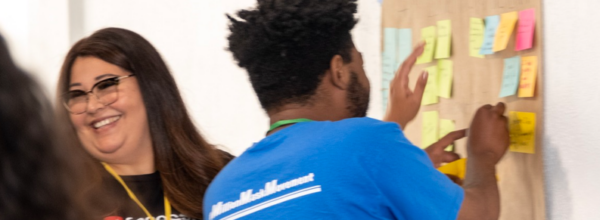
The phrase “community partnerships” typically conjure up images about warm, like-minded people collaborating together towards a common cause or mission. But such relationships can have a dark side and their share of obstacles—and even a toxic or traumatic impact. That’s why it’s so important to choose your partners carefully and get things right from the start.
In the first of a series of community conversations for the Amplify Healing Connections cohort, CCI hosted a panel of coaches working with Amplify teams on the topic of partnerships as prevention.
What makes community partnerships successful? And what elements help create an atmosphere where joint collaborations can thrive? That was the premise of an hour-long discussion this April. Three key values emerged as crucial to the success of collective action. Coaches pointed to respect, trust, and vulnerability as the critical ingredients in effective community partnerships.
Setting the framework for the discussion, the coaches began by talking about why we engage in partnerships. The intention is to maximize strengths and opportunities and minimize challenges, according to CCI coach Will Roy, associate director of community education and partnerships at Safe and Sound, a child advocacy organization based in San Francisco.
Respect goes deep in terms of levels and layers, but people in partnerships want to be seen, heard, valued, and respected, says CCI coach and licensed therapist Colette Reid-Horn of Horn Development Consulting, an organization that creates safe spaces so people can have such experiences. Taking ownership and thinking about what you’re willing to do to ensure the success of a partnership is an important first step, adds Aaron Horn, a fellow coach/therapist/mentor who works alongside his wife.
Here are some major takeaways from the session:
- Establish a personal connection. “Every successful partnership that I have been a part of has two common themes,” says CCI Program Manager Jacqueline Nuila, who has a background in working with youth organizations. The first? “It’s all about personal relationships. Build a connection.”
- Be honest. The second trait that Nuila says signals the beginning of a successful partnership: Be forthcoming, honest, and transparent. Admit when you need help or support or someone else’s skill set, adds Nuila: “You don’t have to be the expert on everything.”
- Show up. It sounds obvious, simple even. But being present—not just for yourself but also for other people—can be difficult to do. Be your true, authentic self. Be willing to meet people where they’re at and have some flexibility, says Roy. “Offering grace in a partnership is important: People are not going to show up their 100% ideal self, every time. And that’s fine.”
- Schedule regular check-ins. Consistently assess whether the shared goals of a partnership are still relevant or whether adjustments are needed. Consider whether the journey is still in service to common ground, says Roy. Don’t skip the hard conversations about the needs for pivots, transitions, or endings.
- Take time to grow relationships. Be intentional, thoughtful, and make time to assess who you’re partnering with, says Aaron Horn. Get to know what a person or organization is about. Are they who they say they are? Are they a good fit? It’s okay to slow down the process of partnering, says Horn, who adds that people are sometimes too quick to partner with an organization or individual and then have to deal with the fallout.
- Practice the power of the pause. In partnerships we can move too fast and not listen to signals or pick up on cues that something is awry or there’s a disconnect. Recognize when alignment is no longer there, says Colette Reid-Horn. Listen to your gut. And make space to think things through. Are there steps that can be taken to make adjustments before ending a partnership that is no longer working?
- ‘Consciously uncouple.’ While the term made popular by the celebrity set doesn’t resonate with everyone, the concept itself has merit, Nuila maintains. Take the time to disengage respectfully from a partnership to avoid burning a bridge or ruining a relationship. Not all partnerships work, and sometimes they run their course. Acknowledge and make space for sharing difficulties so everyone can feel heard and move on.
- Offer incentives to people with lived experience who share their story. Center and honor people who tell their stories, which can be re-traumatizing. Give them a reason to talk about their experiences—even if it’s a small gesture such as a gift card, T-shirt or a meal. Adds Roy: Include people with lived experience in all levels of the process, not just when it’s beneficial for the partner organization.
- Prepare to have some uncomfortable conversations. Don’t walk on eggshells or ignore the elephant in the room, no matter how awkward things can get. Expect and plan for dissent: Everyone isn’t going to agree on everything all the time. Ask people: What do you need? How can we move forward? Be real from the jump and put a name on a problem. Talk candidly about your organization’s reputation, strengths, and weaknesses.
- Craft community agreements. Develop core partnership ground rules and recognize they may need to change or adapt over time. Lay the foundation for such shared tenets in the beginning. Discuss problems in partnerships that have caused harm and work to avoid those triggers. Stay open to what members need. One Amplify team, Healthy Black Families, had partners who listed “good food at meetings” as important. Explained one team member: “When you have good food, you can get people to talk about pretty much anything.”
Amplify Healing Connections seeks to strengthen interventions designed to prevent domestic violence and promote health and well-being for adolescent youth and their adult allies. Launched in March 2021, the 22-month program, with funding from the Blue Shield of California Foundation, is a collaboration with six California-based, multi-sector partnerships, each involving at least one community-based organization and one health care provider serving youth 12-18 years old. Youth-service organizations play a pivotal role in promoting healthy communication and providing a strong, nourishing environment for young people and their caregivers. Coordinated efforts across community organizations can amplify positive childhood experiences (PCEs) that can help prevent, reduce, and even reverse the impact of early adversity.
Image credit: Shutterstock
Other stories in this series:
Find this useful or interesting? We’re constantly sharing stuff like this. Sign up to receive our newsletter to stay in the loop.


